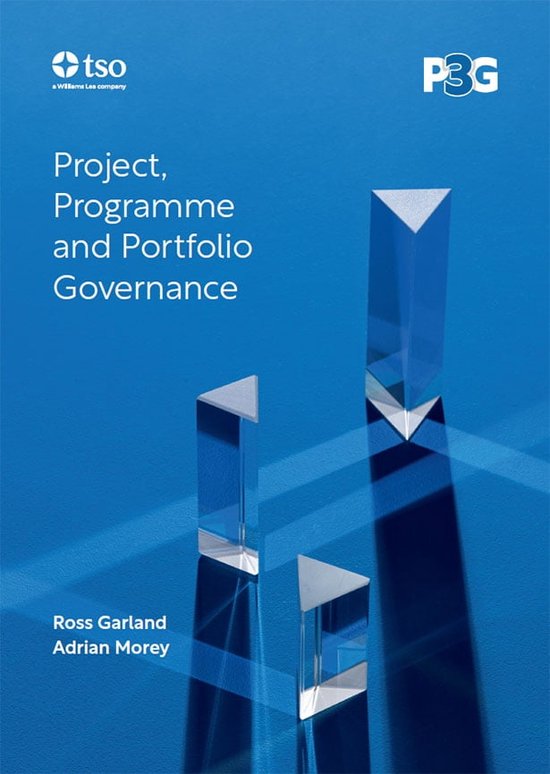
The book Project, Programme and portfolio governance (P3G), by Ross Garland and Adrian Morey is a comprehensive and practical guide to realize optimum outcomes and benefits characterized by:
- Right decisions at the right time
- Right people in the right roles
- Right accountabilities, responsibilities and delegated authority
- Right structure
- Right information.
The book is divided into 5 chapters. The Introduction chapter discusses the target audience (governance body members, project, programme and portfolio managers, PMOs, …)., the organizational context and the benefits of effective and efficient P3G. The second chapter – What is P3G? – gives definitions of projects, programmes and portfolios and their relationships. It summarizes the fundamental components of a P3G framework – structure (avoid decision-making gaps and overlaps), people (focus on roles, not people) and documentation (investment grade artefacts). These components are explored in the next chapters via principles and their application.
Chapter 3 – principles of P3G, forms the main part of the book. P3G is based on ten principles of effective and efficient project, programme and portfolio governance:
- Principle 1: Treat Change differently from Business as Usual
- Principle 2: Ensure a single point of accountability for each project or programme
- Principle 3: Business outcome accountability determines project or programme accountability
- Principle 4: Support the person accountable for a project or programme with a governance board
- Principle 5: Separate project and programme decision-making from stakeholder engagement
- Principle 6: Align investments with strategic objectives.
- Principle 7: Maintain the business case
- Principle 8: Design portfolio governance to drive investment outcomes
- Principle 9: Ensure consistent and logical decision-making rights
- Principle 10: Enable evidenced-based decision-making.
Chapter 4 – Application of principles: Implementation – discusses the need for scalability, a risk-based approach to determine the degree of governance required on a project or programme, what it means to establish, document and communicating new or enhanced P3G arrangements and the impact of agile delivery approaches.
The final chapter gives four case studies to show the application of the principles. Case studies regarding a basic project, complex programme, standing programme boards and portfolio governance models.
In the appendices you get an explanation of the business case box, role statement examples, terms of reference templates for governance bodies, in-room practices and behaviours, an enterprise P3G framework template, P3G and organizational maturity and standard governance forms.
Conclusion. If you are familiar with PRINCE2 (Agile), MSP, MoP, P3O and P3M3 you can find a lot of recognition regarding project, programme and portfolio board composition, roles and responsibilities, usage of tolerances (management by exception) and continuous business justification. I like the principles approach; this makes it less prescriptive. New are the SRO and project sponsor delegate roles. Accountability (principle 2 and 3) is strongly positioned. Also, the emphasis on decision-making rights is definitely an improvement.
What I miss is the governance needed by organizations who made the transition towards an agile organization with permanent cross-functional agile teams. This is much more than a temporary project organization using an agile delivery method. I would call this product governance (P4G?) with at least a quarterly heartbeat to define the initiatives for the coming quarter and not, as described in the guide, an annual cycle. Here you don’t see temporary project or programme boards but quarterly business reviews with business owners, product owners and delivery teams to look backwards, did we deliver what we promised, and look forward, what can we do differently next period and what are the objectives and underlying initiatives for the coming period, in many cases supported by an Obeya room.
In the book Agile portfolio management (EN Amazon, NL managementboek), I wrote together with Rini van Solingen I would position P3G at the left side of the continuum from plan-based portfolio management to discovery-based portfolio management.
If your organization is positioned at the plan-based portfolio management side, this book is definitely a must read.
To order P3G: managementboek.nl, bol.com, amazon.com
















Great post
This is an excellent overview of the book Project, Programme and Portfolio Governance (P3G). I appreciate how the book explores the ten principles of effective and efficient project, programme and portfolio governance. However, I have a logical question – is there any emphasis in the book on the governance needed by organizations that have transitioned towards an agile organization with permanent cross-functional agile teams? What I mean is product governance (P4G) with a more frequent cycle than the annual cycle described in the guide? Thank you for writing this informative post!
Hanna
RadiantBeautyCare.com
Pingback: Overview of my year 2023 book reviews | Henny Portman's Blog